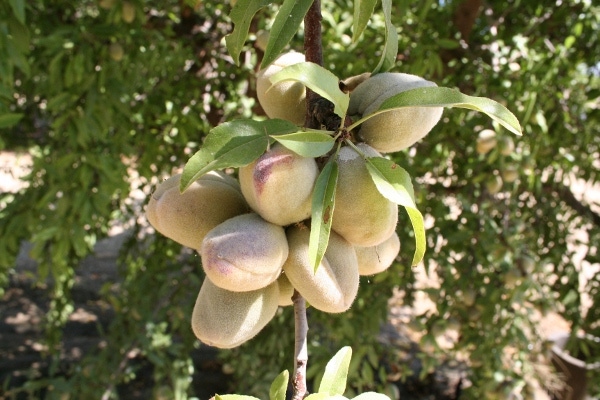June 15, 2016

Most of California’s nut industries got some good news with the announcement that the European Union was extending its maximum residue limit (MRL) for phosphite-containing products until March 1, 2019, retroactive to Jan. 1, 2016.
This means growers of almonds, pistachios, and walnuts can continue to continue to ship nuts with a level of 75 parts per million (PPM). The extension does not apply to pecans which must meet the proposed 2 PPM standard.
For now, the higher standard also applies to cashews, hazelnuts, and macadamias.
Phosphites are used to varying degrees by almond, pistachio, and walnut growers to combat Phytophthora and Pythium which can cause root rot, tree death, and severely reduced yields.
“Almond growers really like them for rainier conditions,” said Gabrielle Ludwig, director of sustainability and environmental affairs the Almond Board of California (ABC). “They believe their trees are happier. They use them for root health and to enhance the plant’s immune response system.”
She sees the MRL extension as good and hopes the higher level MRL will also be applied to pecans.
The ABC said there is not good data correlating different rates, timings, or types of applications with residue levels. The compound moves in the phloem and xylem of the tree.
Preliminary data has shown that residues can carry over from year to year, indicating they do not break down quickly and may be stored in the tree. Since the plant takes up the compound internally, residues are not just on the outside of the tree.
Ludwig said it will take some time to determine residue levels and how they originate. That’s the reason for delaying the stricter MRL.
“The earliest we could submit data on residue trials is the summer of 2016,” she said. “Then, to go through the regulatory process it will take a couple years at their end.”
Ludwig said measuring phosphite residues correctly is difficult.
The ABC said there are no health concerns associated with the residues. The Environmental Protection Agency has exempted potassium phosphite as a fungicide from tolerance due to its low toxicity. Even the European Food Safety Authority does not have health concerns for phosphite.
Ludwig said steps to lower MRL levels were triggered in December 2013 with tests of walnuts on retail shelves in Europe. Since growers had already applied phosphites, they received a temporary reprieve from proposed stricter controls on the 2015 crop. For the 2015 crop, the temporary MRL was set.
Ludwig said the stricter control was triggered when the EU changed the categorization for phosphite to a pesticide, not a fertilizer.
She said it was aimed at a product called Fosetyl-Al which California growers do not use but which contains phosphite residues.
Almonds log the largest agricultural export value to Europe. Thirty percent of the California crop goes to Europe, Ludwig said.
Mark Brady, western marketing manager for Plant Food Systems Inc., which is headquartered in Florida, says that if phosphites are withheld from the industry, average yields would suffer a 20 to 30 percent decline and there are no affordable substitutes available either in terms of disease control or safe food standards.
His company sells K-Phite 7LP Systemic, which he says has both a prophylactic action – it prevents some diseases – as well as curative action, something competing products don’t offer.
Greg Browne with the U.S. Department of Agriculture’s Agricultural Research Service, along with Mario Viveros, then University of California farm advisor in Kern County, published reports in 2005 showing that judicious applications of phosphate-containing materials help control both Phytophthora citricola and P. cactorum in almond orchards.
They found that single postharvest foliar treatment with potassium phosphite a month before leaf fall or a single foliar spring treatment with potassium phosphite after leaf out were effective in controlling Phytophthora. Applications before leaf out were not effective. This work was co-funded by the ABC.
More recently, Themis Michailides, UC plant pathologist and lecturer, has tested efficacy for control of Botryosphaeria in pistachios which may be applicable to almonds.
Bob Klein, manager of the California Pistachio Research Board, said that of the nut industries in California that pistachio probably uses the lowest amount of phosphites.
“Rootstock we use is quite resistant,” he said, though trees may benefit when planted in heavier soils with a higher water table or drainage issues.
Ludwig points out that relative acreage of the different crops is also a factor, with pistachios at around 300,000 acres, walnuts at 400,000 acres, and almonds at a million acres.
Klein said the MRL may be a result of “cultural differences” between the U.S. and the EU. Each region has different levels of concern.
“The EU hardly cares about foodborne diseases such as salmonella,” Klein said. “They are concerned about chemical contamination, and we are concerned about bacterial contamination.”
For those applying materials with phosphite compounded micronutrients such as calcium or zinc rather than potassium, the Almond Board said it’s best to consider when the plant is most likely to take it up, and use the micronutrient from the leaves in order to time the application.
The Board notes that while resistance development is slow it has been found in other crops and say repeated doses of phosphite-containing products should be avoided.
You May Also Like




